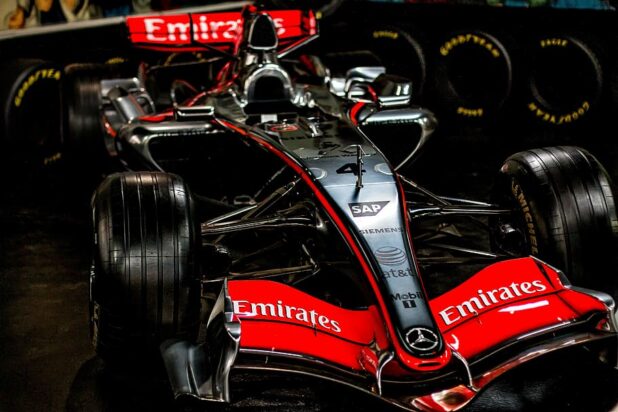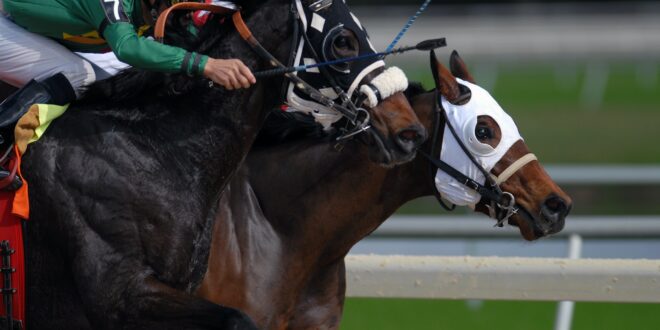Caption: It would be interesting to see how flats or jumps jockeys would get on if they were put in an F1 cockpit Ever since the rise of Formula 1 racing, motorsport has had an affinity with the world of equestrianism. This is evident in everything from Ferrari’s famous prancing horse logo to certain drivers being nicknamed after long-nosed beasts.
In this article, we take a look at all the ways horse racing jockeys and F1 drivers are cut from the same sporting cloth, from the way they diet and train, to how they go about preparing for a big race.
Table of Contents
Drivers and Jockeys Know How to Harness Horsepower

Horsepower is talked about by car enthusiasts as though it had nothing to do with the animal kingdom and everything to do with engines. However, the phrase first came about exactly because James Watt used to measure power by conducting experiments powered by workhorses.
Since the 18th century, when Watt was devising his power measurement systems, jockeys and racing drivers alike have learned to hone the respective power sources they have at their disposal. All this means is that both know when to push their beast or vehicle to the limit, as well as when to ease off the throttle or whip so that horse or car can fight another day.
Weight Considerations Mean Similarities in Diet and Lifestyle

Something that many sports fans most probably will have already noticed is just how diminutive and slight both jockeys and racing drivers are. This is because weight is of the utmost importance in both forms of racing. Horses are often handicapped for big races that take place at the Cheltenham Festival or the Aintree Grand National, so the last thing an owner or trainer needs is a jockey who is piling on further pounds.
Indeed, one of the many considerations that betting punters make in the lead-up to a big race meet is not only the shape a horse is in but whether a jockey is having trouble shedding weight due to injury or illness. Of course, if trawling the social media feeds and horsy news columns to find this out is too time-consuming, then racing lovers can always just check in with the Aintree or Cheltenham tips and insights that are collated by comparison websites like Oddschecker.
Although F1 teams do not have their cars handicapped in order to level the playfield, drivers are expected to maintain a certain weight. This is because cars are fine-tuned to drivers’ bodies, meaning that an added few pounds or ounces can make all the difference to breaking speeds and suspension differential.
All this means that jockeys and racing drivers must stick to strict diet plans. They also have to ensure they maintain a good weight during their off-seasons, so they are not forced to lose too much in a short period of time. Most drivers and jockeys are teetotal and will rarely be seen indulging in calorific cakes and deserts. Some even resort to chowing down on just one solitary meal every 24-hours.
Training Varies, but is all Aimed at Getting the Same Result

Obviously, when body weight considerations are so key to their jobs, jockeys and drivers are somewhat limited to the sorts of training they should do away from the stables or the race track.
Both sets of athletes need a certain base level of cardio fitness so that they do not start blowing halfway through an important race, or lose concentration coming down the final straight. However, that is where the similarities end.
Jockeys need to focus on leg and core strength to ensure they stay perfectly balanced when perched atop their thoroughbred mounts. The best training for impacting such muscle groups is riding itself, and that is why most jockeys’ fitness training is done atop a horse. The same cannot be said for drivers, who have to rely on HIIT classes and similar full-body training programs to ensure their bodies can resist the g-forces and wind buffeting that they experience in an F1 cockpit.
Warm weather training is also something that F1 drivers like to engage in, not only because they enjoy having the sun on their backs when they put hard work in, but also because temperatures can get uncomfortably high in an F1 driver’s seat. Allied to this, many of the races on the F1 calendar take place in red-hot destinations in the Middle East and Asia. The same applies to jockeys who ply their trade in similar countries or on southern hemisphere racecourses found in spots like Australia.
An eye for the Racing Line

Away from the training and preparations, the one thing that connects jockeys and drivers perhaps more than anything else is the ability to spot a racing line or display flawless in-race IQ.
For jockeys this means judging whether to lead from the front or come with a late charge, depending largely on what it is their horse prefers. They also have to be careful not to get boxed in on the rail, while conversely not running unnecessary furlongs on the outside of a bunched field.
Many of the same factors are taken into account by F1 drivers and their teams, who have to know when to push for an overtake or bide their time for a better moment to pass.
Meanwhile, just as jockey must always keep their horse in mind when devising race tactics and approaches, drivers must do the same with their cars. Some machines are even more temperamental than thoroughbred racehorses! Finally, both jockey and F1 drivers must carry with them an unrelenting will to win. At the top level, this is essentially what divides the wheat from the chaff in horse racing and F1 alike.
 World Magazine 2024
World Magazine 2024






